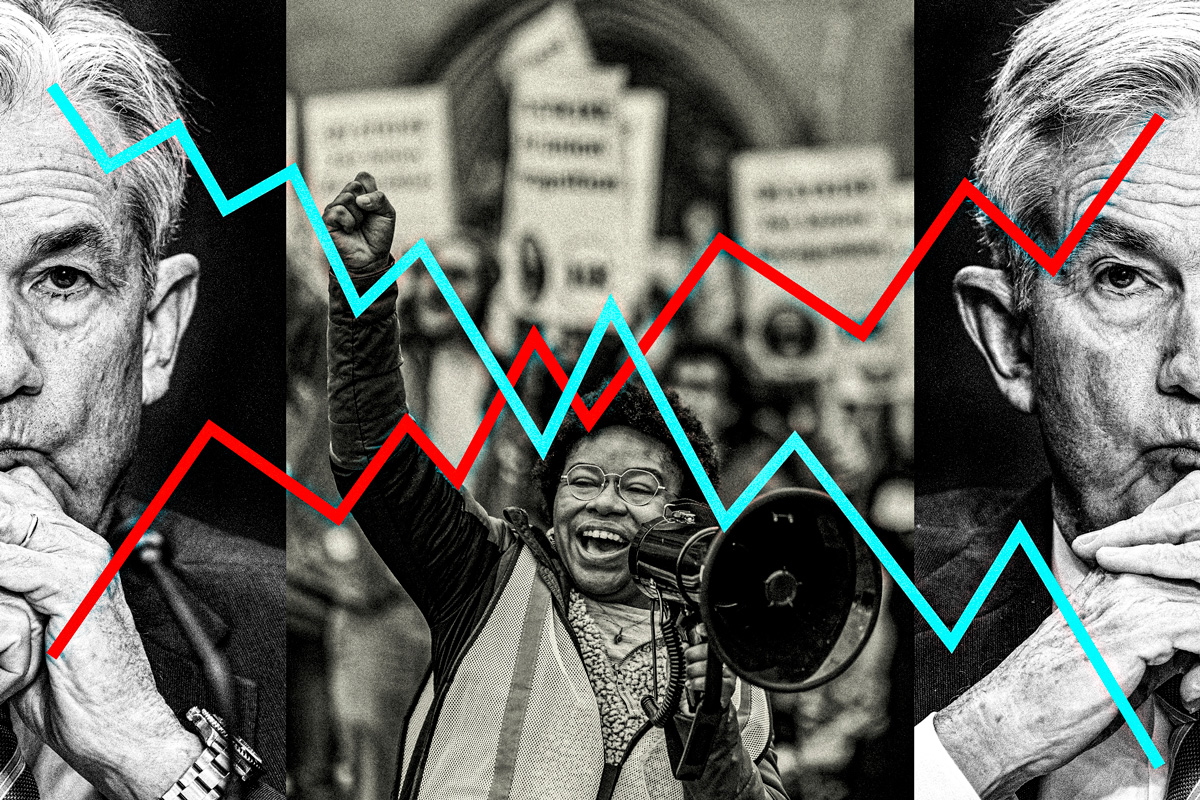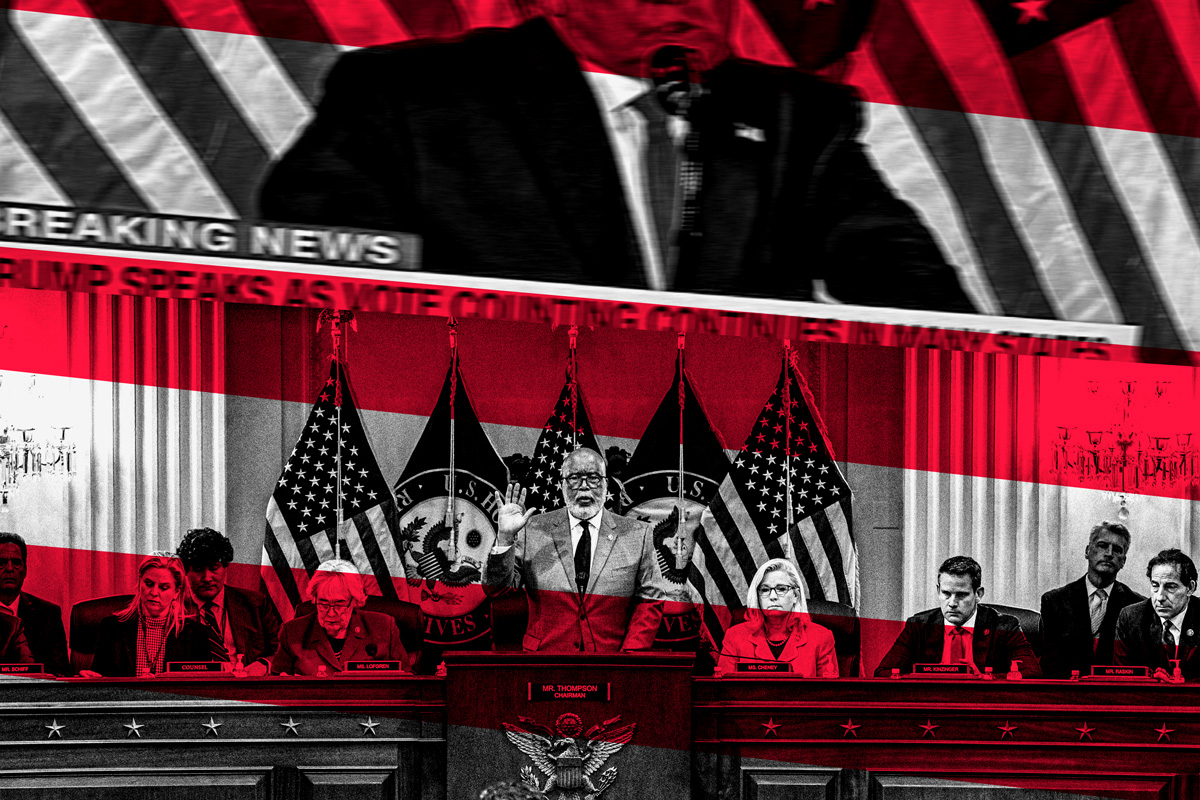Inflation in the U.S. is now 8.6 percent—the highest rate it’s reached in 40 years. So Jerome Powell, the chair of the Federal Reserve, took pains during last Wednesday’s Semiannual Monetary Policy Report to Congress to outline what the Fed is doing to combat the specter of runaway inflation.
The common understanding of inflation that informs much of our policy making holds that it’s largely grounded in a classical economic mismatch: too little supply and too much demand. But this view of things is overly simplistic. For starters, reducing inflation to simply a matter of supply and demand raises what are at bottom priorities of our political economy: the questions of too little supply of what, too much demand from whom—and, most important, why an imbalance between the two exists. Powell’s breakdown of these issues followed suit, demonstrating that the policy response we all will live through largely depends on which measures of economic health prevail. In other words, the question of how to fight inflation is an inherently political one—in much the same way that Washington’s other power-and-policy elite atop the U.S. Supreme Court is a deeply political body.
Of course, like the high court, the Fed claims it is an apolitical institution divorced from—and, consequently, uncontaminated by—monied and other political interests. But as is the case for the legal world, this is a myth. Indeed, over its century-long run of setting monetary and fiscal policy, the Fed, like most American institutions, has a strong bias toward business. It’s no great surprise, then, that its periodic wars on inflation tend to strongly serve the interests of the business community.
Since communities of color are vastly over-represented in the ranks of wage earners and debtors due to the historical legacies of racism, the Fed’s war on wages poses dire potential consequences for their livelihoods and well-being.
This is particularly true for the politics of indebtedness: during inflationary runs, the holders of contracts for debt lose revenue as borrowers pay debt back in depreciated currency—while debtors can realize some corresponding gains (even though, of course, general conditions of price inflation also damage their overall buying power). So what may appear as a narrow technocratic effort to reset the terms of policy for the sake of taming inflation plays out in reality into additional support for the bankers and financial institutions who control access to credit. This has been the central constituency the Fed has served in its battles against inflation.
This is the institutional backstory to Powell’s congressional testimony last week. The centerpiece of his strategy to realize price stability in an economy largely overheated by the easy-money policy of rampant “quantitative easing” (i.e., virtually zero-interest access to the money supply for banks and Wall Street) is a plan to tackle inflation at the other end of the economy by slowing wage growth. In an already tight and Covid-battered labor market, this strategy risks the onset of a recession—as Powell himself now concedes. While stipulating that the Fed was in no way seeking to “provoke” a recession, Powell also observed that “monetary policy is a blunt tool” capable of producing “weaker outcomes”—which in the jargon of Fedspeak usually translates into “recessions.” Since communities of color are vastly over-represented in the ranks of wage earners and debtors due to the historical legacies of racism, the Fed’s war on wages poses dire potential consequences for their livelihoods and well-being.
When Powell earlier announced the Fed’s policy shift, he laid out a far different scenario—indeed, he insisted that lowering wages could help stave off a recession. At a May 4 press conference, he explained why he believed raising interest rates in the present economic climate could help restore the now-elusive balance between supply and demand and thus lower inflation. “In principle,” Powell said,
it seems as though, by moderating demand, we could see vacancies come down, and as a result—and they could come down fairly significantly and I think put supply and demand at least closer together than they are, and that that would give us a chance . . . to get wages down and then get inflation down without having to slow the economy and have a recession and have unemployment rise materially.
On paper, in the oversimplified models of introductory economics classes, the recalibration of supply and demand seems intuitively sound: to bring prices down, demand must slow down, and rising interest rates are the most reliable tool at the Fed’s disposal to ensure that outcome.
Simple, right? Not when you take a closer look at the real economy—and again at what sort of economic balance the Fed is seeking to strike in the service of which particular economic interests. As Powell’s subsequent pronouncements have made clear, the Fed is not really focusing its attention on the inflation gripping the consumer markets—which rank-and-file Americans feel acutely at the gas pump or grocery store. This everyday price inflation, the Fed claims, is beyond its power to control. No, the culprit behind our present inflationary binge, Fed officials agree, is wage inflation in the labor market—and reducing wage growth is the chief aim of the tightened access to credit the Fed is now implementing.
One likely side effect of this approach would be to rein in a recent surge of union organizing in a labor market where—unlike the more passive behavioral dynamics in the consumer market—workers control the supply. In the classic textbook model of labor supply, businesses will demand the labor power they believe they require in order to keep pace with consumer demand. If companies come to think their workforces are bigger than consumer demand justifies, they’ll shed workers via layoffs and other wage-reducing measures.
Because many Americans of color have, on average, less wealth than white Americans, they will have a greatly diminished store of resources to navigate an economy in recession.
In tighter labor markets amid conditions of generalized economic growth, however, employers must do more to compete for workers. Consider the impact of Covid in the sprawling service-sector economy, where Black workers are over-represented: Faced with the risk of contracting a highly contagious virus whose long-term effects are still unknown, many workers have turned down the traditional terms of service-sector employment and demanded additional incentives before taking jobs—higher wages chief among them.
But with higher interest rates poised to dampen credit access, and hence plans for economic expansion across the economy, the bargaining advantages many workers now enjoy may melt away. And again, this is the outcome the Fed is deliberately aiming to achieve: With fewer jobs to choose from, the reasoning goes, workers will no longer be in a position to demand higher wages. The Fed hopes that fewer dollars in people’s pockets will result in fewer dollars to spend on consumer goods—and that this, in turn, will curb inflation in consumer markets.
Again, the impact of this twin effort to dampen wages and diminish the demand for employment in tight labor markets poses serious consequences for workers of color in the real economy. The reason is simple: the existing wage and employment market structure suffers from pronounced racial disparities. At any given moment, people of color are, on average, likely to earn lower wages than white workers, and are more likely to be unemployed, due in no small part to racism. (Black students are also over-represented in the student-debt market, which opportunistic interests on the right are already targeting as an additional driver of inflation by the Fed’s logic, should President Joe Biden’s limited student-debt forgiveness plan go into effect.) In practical terms, this means that the Fed’s adoption of interest rate hikes to curb inflation will accelerate these structural racial disparities. And because many Americans of color have, on average, less wealth than white Americans, they will have a greatly diminished store of resources to navigate an economy in recession.
Admittedly, there is no one cause of inflation, and combating it will always produce winners and losers in a capitalist economy that engenders inequality as a matter of course. But the way political elites address inflation is, at its core, a question of political priorities. Through its steadfast drive to “get wages down,” the Fed has made it abundantly clear whose priorities it serves—and they aren’t the priorities of the poor, working, and nonwhite people who are least able on their own to weather the economic storms ahead.
Jared Clemons received his Ph.D. in political science from Duke University, where he studied race and political economy. He is a postdoctoral research fellow at Princeton University’s Center for the Study of Democratic Politics.



